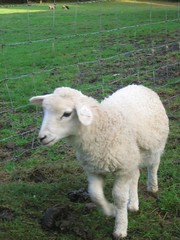July Lambs

It's obviously not July when I am writing this, but August got away from me this year and I couldn't very well write about things that happened later if I didn't mention our unexpected arrivals (x 4), ... proving to me there are reasons why rams are only left with the ewes for two months and not four!
Imagine my surprise to come out for feeding in the last weeks of July and notice one of the ewes hanging back in the shade of the alder trees. Why was she standing there, when the rest of the flock had made a mad dash to the barn at the sound of Pavlov’s dinner bell? And, why was I hearing the bleat of baby lambs? Lambing season was over in May. I hiked out to take a look, came back to finish my feeding in the barn, and walked to the house for some help, counting weeks and months as I went.
“Greg, I need your help.”
“What’s the problem?
“We have more lambs. Triplets way out in the field and the mother isn't coming in.”
We didn’t speak as we hiked back over to the barn field. Greg wasn’t asking questions. I thought, what was the darned gestation for ewes? How could this be happening now? I knew that my woolies and Katahdins naturally segregated themselves by breed, and, of my eight woolies, four had not lambed this year. A dismal number at 50%. Until now. Our ram must have snuck up on my orange- tagged Suffolk his last day of freedom. Sly dog! On top of that, it was a bad idea to have lambs in the summer because of something called Fly Strike, one of the most disgusting phenomena I have experienced on the farm. Flies lay eggs in the baby poop, which ultimately turn into maggots, that proceed to eat the baby alive. How do I know this? We lived through it last summer with one little lamb I nursed back to health, only to have her swept down the river with the winter rains!
We grabbed the babies out of the field, two for Greg and one for me and headed back toward the barn. The ewe followed us in alarm, stomping her feet, running in circles around us, chasing the dogs with her head down. Once secure in the sheep stall, we began to assess the health of our small charges. The heat of the day had been hard, and I ended up milking the mom and tubing two of the lambs, a method of threading a tube through the mouth and into the stomach, then pouring the milk in directly. It’s a quick way to ensure sustenance, hydration, and Colostrum. By the end of the second day, I was sure the ewe was rejecting one of her three lambs, no matter how hard I tried.
As if it wasn’t bad enough we were dealing with lambs, and a bummer lamb, in the middle of the summer, Greg and I had plans to leave for a 10-day vacation in two days. Our neighbors, Karen and Allen, had agreed to farm-sit! Under the best of circumstances, house sitting a farm takes a special type of friend. If leaving them with new born lambs was ‘above’ the call of duty; leaving them with a bummer was way ‘beyond’. Instead of reviewing simple feeding instructions for the horses, like flakes of hay and cans of grain, we had to go over how to mix and feed a powdered milk formula and how to spray lamb butts for flies!
“So, Karen, are you and Allen okay with making up formula for the lamb, heating it, and feeding 4-6 times each day while we are gone? Oh, yeah, and there’s a cougar issue…”
Karen blinked and smiled, tipped her head and said in her unflappable, soothing voice, “We’ll be okay.”
I shouldn’t have worried. Our intrepid neighbors took the triplet lamb thing in stride. Luckily, they had helped with baby lambs before. That they had to deal with another ewe delivering two days into our trip was just icing on the cake! The local neighbor vet’s suggestion they keep an eye on a third ewe almost sent them over the edge, but they came back off that edge a week into our trip. No more lambs; the farm chores became more familiar; the bummer lamb took a full bottle and even sneaked a drink now and then from her mom, and Karen and Allen finally found all the light switches in the house.
Lammie at 2 months old
All Rights Reserved. Copyright 2007 Scottie Jones